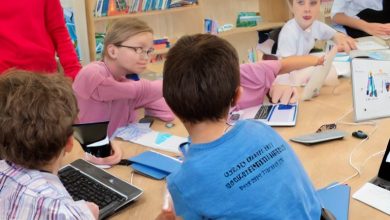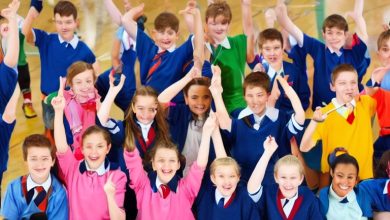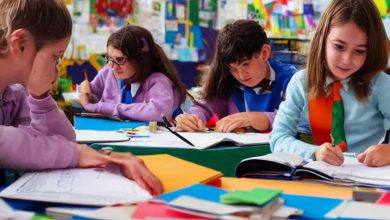Navigating the Spectrum: A Journey Through UK Special Education

Sailing across the ocean of knowledge is inherently challenging, but what happens when your ship veers off the prescribed course, pitching towards the path less traversed? “Navigating the Spectrum: A Journey Through UK Special Education” bids you to embark on a unique voyage, an exciting exploratory journey through the labyrinth of the United Kingdom’s education system. As we dive into uncharted, rainbow-hued waters, this expedition will take you into the depths, decoding the complexity, decoding the nuances and celebrating the triumphs of special education in the UK. Set your fears aside, open your minds and hearts, and prepare to encounter a world, both challenging and rewarding, that breeds in the heart of diversity. It’s time to navigate the spectrum.

Unravelling the Maze: Understanding the UK Special Education System
Navigating through the labyrinth of the UK Special Education system may initially appear to be a daunting task. With a plethora of acronyms like ECHP (Education, Health and Care Plan), SENCO (Special Educational Needs Coordinator) and PEP (Personal Education Plan), it can feel like learning an entirely new language! The process involves learning to identify the unique needs of each child: understanding where they fit on the spectrum and how their specific challenges can best be addressed within the framework of the system. However, with patience, persistence, and a willingness to fight for your child’s rights, you can master this system and ensure your child receives the best possible support.
Do not be disheartened by the seeming complexity of it all. Learning special education law is not necessary to be an amazing advocate for your child. Understanding a few key concepts can make a world of difference. Firstly, comprehend that each child is entitled to an assessment process to determine their specific needs. Secondly, understand that a child’s entitlement to special education is not restricted solely to those with a diagnosis. Children who are struggling but undiagnosed are equally entitled to support under the law. And finally, be assured that the law is there to protect and safeguard the rights and needs of your child, and to ensure that they are given the best possible opportunities for growth and education.
-
- ECHP (Education, Health and Care Plan)
-
- SENCO (Special Educational Needs Coordinator)
-
- PEP (Personal Education Plan)
| Term | Full Form | Description |
|---|---|---|
| ECHP | Education, Health and Care Plan | A legal document outlining a child’s special educational needs and the support they should receive. |
| SENCO | Special Educational Needs Coordinator | A school staff member who is responsible for coordinating special education services at the school. |
| PEP | Personal Education Plan | A document that outlines a child’s educational targets and the strategies to meet them. |

Never Walk Alone: Support Systems Within UK Special Education
Walking through the journey of special education in the UK, we find a labyrinth of resources dedicated to supporting learners and their families. This robust system acknowledges that every child is unique, requires different types of assistance and that no one should ever walk alone. Guardians, educators and specialists come together to carve out an educational path that respects the child’s individual needs while fostering their strengths and talents. Here are just a few examples:
-
- Individual Education Programs (IEP): These personalised learning plans are crafted by professionals and parents to meet the unique learning objectives of children.
-
- Special Educational Needs Coordinators (SENCOs): SENCOs are on hand in every UK school to facilitate support for special needs learners, acting as a liaison between parents, teachers, and outside resources.
-
- Parent Partnerships: These services offer parents guidance and information to navigate the special education system effectively.
Coordinated and consistent interaction is key to successful functioning of the various resources embedded within UK’s special education. An intricate network, it is designed to empower students and build a cohesive link between home and school. Through a collection of services and policies illustrated below, the UK’s special educational support system ensures that every individual has the opportunity to thrive and evolve in a nurturing environment.
| Service/Policy | Function |
| SEND Code of Practice | Guidance for education providers on identifying and supporting students. |
| EHCP (Education, Health and Care Plan) | A legal document outlining a child’s special education, health and social needs. It specifies the additional provision necessary for the child’s progression. |
| The Local Offer | Information on education, health and care services, leisure activities and support groups in the local area. |

Beyond Textbooks: Exploring Unique Teaching Methods in Special Education
As educators navigate the diverse landscape of special education in the UK, there is an increasing shift from traditional textbook-focused methods towards unique, creative and engaging teaching strategies. Recognising that every learner is different, particularly those with special educational needs (SEN), these novel approaches aim to meet students where they are and enrich their learning journey.
Visual Learning emphasises the use of images, charts, and other graphical representations to convey information. For learners who struggle with text-based information, visual aids can make abstract or complex concepts more digesturable. It aids understanding and often sparks the creative side of learners. Similarly, Experiential Learning is a hands-on approach that involves direct experience and focused reflection. It encourages learners to connect theory with practice and engage more fully in the learning process. In the same vein, Kinesthetic Learning involves moving and doing. It’s an ideal approach for learners who have difficulty sitting still and focusing on traditional lessons as they have the freedom to learn through physical activities.
| Teaching Method | Learner Benefits | Example in Practice |
|---|---|---|
| Visual Learning | Enhanced understanding and creativity | Using infographics to explain the water cycle |
| Experiential Learning | Connecting theory with practice | Growing plants to understand photosynthesis |
| Kinesthetic Learning | Learning through physical activity | Dance routines to memorise multiplication tables |
Increasingly, UK special education is weaving these unique teaching methods into their curriculum. The aim is to not only make learning accessible for SEN students, but to empower them with the skills and knowledge to confidently navigate the broad spectrum of life’s experiences.

Adaptive Options: Tailoring Education to Accommodate Needs
When it comes to special education, the United Kingdom has a plethora of choices to ensure every learner gets tailored instruction. One aspect of this tailored approach involves effective, targeted strategies called Adaptive Options. These are educational practices, and even lifestyle shifts, that cater specifically to the unique needs and abilities of every child.
-
- Personalised Learning Plans: This involves tailoring lessons and activities to a student’s interests and skills, and taking their learning styles into account. The aim is to engage each student at their individual level, and boost their enthusiasm to learn.
-
- Therapies: Many learners benefit from various therapies like occupational therapy, physical therapy and speech-language therapy, which can be integrated into the school day.
-
- Assistive and Adaptive Technologies: Here, technology is wielded to empower students — from adapted keyboards and computer interfaces that make inputs easier, to tools that transform text into speech, thus breaking down learning barriers.
Take a Glimpse at the Variety
The table below provides an encapsulating glimpse into the spectrum of adaptive resources in UK special education:
| Type of Adaptive Option | Possible Implementations |
|---|---|
| Personalised Learning Plans | Learning portals, differentiated instruction |
| Therapies | In-school therapies, therapeutic classes |
| Assistive and Adaptive Technologies | Text-to-speech software, adaptive keyboards |
The takeaway here is that special education in the UK is a kaleidoscope of learning tools and strategies, carefully planned and employed to ensure each child’s unique needs are met.

Changing Perspectives: Employing Inclusivity within UK Special Education
In navigating the landscape of Special Education within the UK, you’re likely to encounter a rich tapestry of experiences, perspectives, and approaches. The push for inclusivity is becoming increasingly in the spotlight, driving a need for greater understanding and adaptation within pedagogical practices. Let’s assess the current state of inclusivity within the UK’s special education sector and highlight some of the significant improvements being undertaken.
Various strategies are being employed to cultivate a more inclusive environment within UK special education. These strategies can be broadly categorised into three primary realms:
-
- Curricular Strategies
-
- In-Class Strategies
-
- Out-of-Class Strategies
Each of these strategies carries its own significance and has its unique place within the broader framework of inclusivity.
| Strategy Type | Examples |
|---|---|
| Curricular Strategies | Adapting learning objectives and outcomes for students; individualising lesson plans; promoting accessible learning materials |
| In-Class Strategies | Encouraging peer support and mentoring; providing additional classroom aids; using technological interventions |
| Out-of-Class Strategies | Creating inclusive social activities and clubs; establishing strong home-school partnerships; providing specialist support services |
The revolutionising wave of inclusive thinking is transforming the sector, bringing attention to the necessity of diverse, adaptable, and individual-centred approaches. As we navigate through the UK’s special education spectrum, we continue to challenge the traditional teaching models, aiming to create spaces that allow every child to flourish.

Onward and Upward: Strategies for Continuous Improvement in Special Education
Embracing a journey in special education requires a strong commitment to continuous improvement. Offering more than just basic academics, it cultivates skill-building, personal growth, and emotional well-being. Especially in the UK, recent transformations in special education led to robust, researched-backed strategies that present new hopes in this field.
It is a given fact that with the right strategies and dedication, we can go onward and upward. Here are some of the comprehensive strategies employed in UK Special Education for continuous improvement:
-
- Inclusive Learning: A priority is given to inclusive learning, ensuring that students with special education needs (SEN) get as much opportunity to learn with their peers. This builds interpersonal skills, empathy, and social adaptability.
-
- Personalised Learning Plans (PLP): Each student is unique, and so should be their learning experience. Individual Learning Plans based on students’ strengths, needs, and goals are designed. Auspiciously, it leads to better academic progress and behavioural improvements.
-
- Collaboration: Collaboration between teachers, therapists, families, and other stakeholders is highly encouraged. This open communication and team approach ensure consistency in teaching methods and strategies across different settings, which is beneficial for students’ overall progress.
-
- Continued Professional Development (CPD): Teachers and professionals involved in special education get regular pieces of training, meetings, and seminars to update their skills and strategies.
-
- Monitoring & Evaluation: Regular assessments are conducted not just on students but also on teaching methods, materials, and resources used. This ongoing evaluation process ensures the effectiveness of the teaching strategies being used.
The following table summarizes the positive impacts of these strategies on students:
| Strategy | Positive Impact |
|---|---|
| Inclusive Learning | Boosts social adaptability and interpersonal skills |
| Personalised Learning Plans (PLP) | Better academic progress & behavioural improvements |
| Collaboration | Consistency in teaching methods across different settings |
| Continued Professional Development (CPD) | Up-to-date teaching strategies |
| Monitoring & Evaluation | Efficient teaching methods and resources |
Remember, the journey of special education necessitates constant evolution, improvement, and adaptation.

Roads Less Travelled: Innovative Approaches in UK Special Education
Taking a less-trodden path, the United Kingdom has been pioneering remarkable and inventive strategies to redefine special education. The focus has shifted from traditional teaching methods to a more personalized approach. The children are no longer perceived as “students with special needs”, but unique learners with equally unique learning methods. Each child’s uniqueness is nurtured and experimented with innovative teaching materials, strategies, and assessment methods to bring out the best in them.
Technology in Special Education
Integration of technology has become an indispensable part of UK special education. Virtual Reality (VR) is one such example. It is used to create a controlled, immersive, interactive, and engaging learning environment. Augmented Reality (AR), on the other hand, superimposes digital elements onto the real world thereby encouraging interaction with the physical environment. Both VR and AR have shown significant improvements in children’s focus, understanding, engagement, and retention. Similarly, Assistive Technology (AT) is being widely used to support children with physical impairments.
| Technology | Focus | Benefits |
|---|---|---|
| Virtual Reality (VR) | Controlled and immersive learning | Improved focus, understanding, engagement, and retention |
| Augmented Reality (AR) | Interactive learning with physical environment | Better interaction and physical engagement |
| Assistive Technology (AT) | Support to physical impairments | Increased independence and participation |
Flipped Classrooms in Special Education
Another ground-breaking method adopted in UK special education is the ‘Flipped Classroom’ approach. Here, the traditional pedagogic method is inverted where students access lecture materials at home and do their “homework” in school. This helps the teacher to spend quality one-on-one time with each student, thereby identifying and working on their individual needs. Being a student-centric method, it also promotes self-learning among the children.
-
- Access to lecture materials at home.
-
- ‘Homework’ done during school hours.
-
- Quality one-on-one time with teachers.
-
- Promotes self-learning.
Stepping out of the norm, these innovative methods are definitely lighting up the road less travelled in UK Special Education.
Wrapping Up
In this journey through UK’s special education landscape, we’ve traced the pathways and crossed bridges, exploring the myriad spectrum of learning from its vibrant hues to its subtle whispers. Our passage has sparked questions, stirred emotions and hopefully, sparked a new understanding of how we approach education with its wonderful symmetries and asymmetries. As we conclude, remember, this exploration doesn’t end here – like the spectrum itself, it’s an ongoing voyage, full of discovery, full of potential. Our minds are our maps and our hearts the compass. Onwards we sail, navigating the spectrum, understanding that in the world of education – specially in special education, truly, one size never fits all.
Stay curious, stay compassionate, stay committed to making every learner’s journey one of discovery, growth and invaluable self-affirmation.



